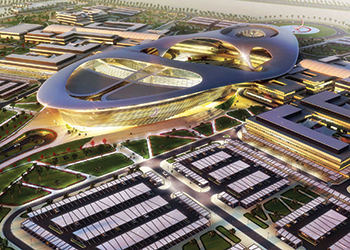Bentley software takes on complex projects
01 October 2016
Bentley software has provided major projects in the region with an integrated BIM (building information modelling) approach necessary to deliver them on time. The processes have helped achieve cost and time reductions while improving quality and information accessibility.
The software has helped some of the most complex projects to be delivered on schedule despite an aggressive timeline. One such project was the Zayed University in Abu Dhabi, which opened its doors in 2011.
For the project, architect Bothe Richter Teherani (BRT) used Bentley’s integrated modelling software to deliver a sustainable, organic campus facility spanning 80 hectares.
Strategically positioned between Abu Dhabi and the city’s international airport, the $817-million Zayed University campus includes academic buildings, recreation facilities, and residential accommodation to serve 6,000 students.
Commenting on the project, a spokesman for Bentley says: “The project required designing a campus to reflect the national identity and architectural heritage of the UAE, featuring a free-form, undulating roof, and a façade of triangular inclined planes. To meet these complex design challenges on an extremely tight timeline, BRT needed an integrated, dynamic modelling solution.”
It was Bentley’s GenerativeComponents and MicroStation that allowed BRT to quickly explore and sustainably design a cladding system for the free-form, 380-by-180-m roof. GenerativeComponents automated the time-consuming manual calculations for each inclined triangle of the façade. The flexibility and interoperability of Bentley solutions enabled BRT to manifest its sustainable design.
“Using Bentley solutions saved significant time by automating previous manual calculations, enabling BRT to deliver the project on time. Bentley software provided the firm with the modelling tools to transform free-form design into quality construction by developing a cost-efficient cladding system for a sustainable, state-of-the-art facility. The curvilinear roof design ensures energy-efficient cooling to reduce costs of air-conditioning in the desert environment,” says the spokesman.
Automating the calculation of rotation and inclination angles for each triangle using GenerativeComponents enabled BRT to generate 21 variations of the façade geometry in two weeks. The software was instrumental in designing the free-form roof spanning 28,000 sq m, and allowed BRT to reduce the 15,000 different cladding elements to a workable number.
 |
Bentley’s BIM software was used to accomplish the Zayed University project in Abu Dhabi. |
Integrating with Bentley’s common engine, MicroStation, provided BRT the tools to study variations in element shape, size, fixing system, as well as material characteristics, to develop a cost-efficient cladding system.
“With Bentley’s integrated software, BRT turned its vision into sustainable construction,” says the spokesman.
Meanwhile, the Madrid office of Arup, an independent firm of designers, planners, engineers, consultants and technical specialists, is using Bentley software to design 90 per cent of its infrastructural projects. The office, which is handling projects worth $30 million in Doha, Qatar, has used BIM processes to achieve cost and time reductions while improving quality and information accessibility.
To modernise the delivery of civil engineering projects being handled by the infrastructure department of the Madrid office, the firm implemented BIM methodologies which are more commonly used for plant and architectural projects.
Arup integrated all engineering disciplines using Bentley applications, applying the BIM methodology to the civil engineering market — specifically campus projects under development in Qatar.
“The roll-out of the first projects in the Middle East where the company employed its new civil BIM technology strategy has already produced a 30 per cent time and cost savings. Information quality and accessibility also have improved. Using the BIM strategy has also reduced the risk of missed delivery deadlines,” says the spokesman.
“Arup has already produced the first projects using Civil BIM strategy, saving 30 per cent of costs,” says Oscar Julián, BIM manager, Infrastructure Department Arup.
Bentley software is now used to design 90 per cent of Arup Madrid’s infrastructure projects. These include AECOsim Building Designer for structures, buildings, and utilities; InRoads for road design; and SewerCAD and WaterCAD for sanitary sewer and water distribution network modelling. All of Bentley’s software products use MicroStation, which allows Arup to work with different programs in the same environment. The products also interface well with third-party software.
Arup’s Madrid office realised significant improvement in performance with the implementation of BIM processes.
- Wireless technology is way forward
- Focus on networking at key exhibition
- Two-way radios are effective on work sites
- Bentley software takes on complex projects
- Firms tie up to create seamless workflows



